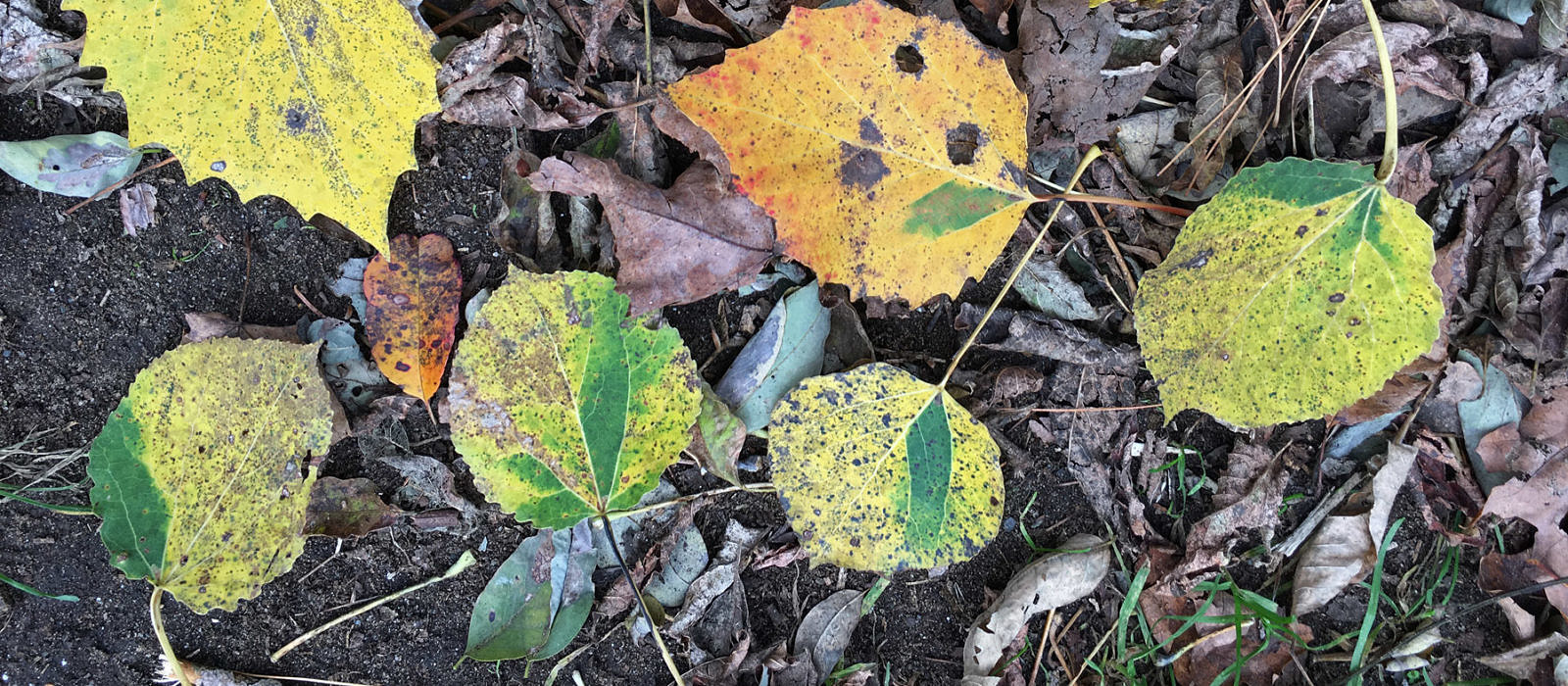
Zombie Aspen Leaves
They're Not Dead Yet
Yellow and brown and down to earth, they might appear dead. Yet they are not quite dead. They are the undead: zombie aspen leaves.
Find them as you walk the damp autumn paths – yellow leaves with a patch of green tissue radiating from the base of the midrib. Here in Vermont, these are mostly Quaking Aspen (Populus tremuloides) leaves, but I also find the green “swoosh” on Big-toothed Aspen (P. grandidentata) and, rarely, Eastern Cottonwood (P. deltoides).

Typical Ectoedemia: larva (with frass) and adults / © Janet Graham (larva) and @ Patrick Clement (adults) – Wikimedia Commons
When a friend and I first encountered these some years ago, I collected a few and queried a handful of smart botanists for answers. Many had theories; none had an explanation. It wasn’t until I put a leaf under a dissecting microscope that I found that the beast lies within.
Residing in a tiny pocket of tissue near the base of the green patch is a translucent caterpillar not much more than 2 millimeters in length. It’s feeding in there; I could see the frass (caterpillar poop). With help from Dave Wagner, the renowned entomologist at the University of Connecticut, we were able to identify the critter as a moth in the family Nepticulidae, perhaps Ectoedemia argyropeza or some other member of that genus.
“The really cool thing is that the larva secretes an anti-senescent substance that keeps part of the leaf alive – probably a cytokinin,” Dave wrote in an email. Cytokinins are plant hormones that promote cell division. In this case, it seems, the caterpillar keeps part of a leaf alive so that it can keep eating.
This moth is also parthenogenetic; females can produce fertile eggs without help from males, which, as it turns out, are quite rare.
For now, however, the caterpillar will continue to dine in the verdant patch of an otherwise dead leaf. It will pupate for winter. And the tiny adult will emerge to fly next year. Many species in this genus are black and white with orange scales around the head. But don’t expect to find one. Your best bet for discovering this animal is to watch the trail this fall for the green patches in poplar leaves.
In any event, if you’re raking them up, please note that some of these leaves … well … they’re not dead yet.

This is the coolest thing ever! Last year I noticed these leaves and wondered why there were these beautiful green patches on the leaves. I found this article and since then, I have shared it with everyone!!!! I work in an elementary school, so I especially love sharing this with the kiddos! Thank you Bryan!!!!
You’re most welcome!
Very cool! Thanks for educating us.
Oh, it’s nice to know that the Zombies are in NYC as well. 🙂
I have been photographing autumn leaves for years, many of them on the streets of NYC, and am happy to learn about the life in the green, Suzanne
I have been photographing autumn leaves for years and am happy to learn about the life in the green. Suzanne
i am equally impressed with the hairy wing margins! The turbulent airflow that these hairs produce is necessary for flight in small critters (and has nothing to do with silent flight). Is this adult less than 20 mm in wingspan?
Great stuff!
Thank you, Brian! I have been collecting these leaves every Fall, pressing them,then tossing them on the dining table for decoration.
I knew the name of the leaf, but had no idea about the green patch. I simply considered it the most unusual one on the trail, my favorite one. Even today I brought home another hand full.. I”m so pleased to know the mystery of the green patch . It makes them even more beautiful.
Thanks for the illumation, Bryan. We would all do well to be so inquisitive. It’s an honor to have you lead the way-
Nature never ceases to amaze me…I have seen these leaves many times…thanks for sharing this incredible information (and for being ubber inquisitive!
I know you have seen Susan Sawyer’s colored pencil (?) drawings of these leaves. They are BEAUtiful! Thank you for sharing the ‘why’. Insects rock! K
That is so cool! I’m going out tomorrow to find zombie aspen leaves. I have a finely screened box to keep them in until the spring. Imagine: grow your own zombies!
Found one! Very cool!